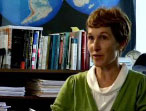 |
NASA | GSFC | JPL | Site Map |
|
|
 |
 |
Education: Student Outcomes |
Filtered by outcome, asset type: 9-12q9, video Click here to begin a new search | |||||||||||||||
Outcome: Explain that ocean science is interdisciplinary and requires new ways of thinking. | |||||||||||||||
Grade level: 9-12 Theme: 21st century technology Video: getting_full_picture.flv Up until now when we've been trying to understand how density changes impact ocean circulation, we've really just had half the picture. Because we've just be able to look at our global coverage of temperature. But with the Aquarius mission, we'll be able to complete that other half. We'll be able to look at the salinity information; and the salinity combined with temperature will give us the information about the density field. Grade level: 9-12 Theme: 21st century technology Video: aquarius_catch_up.flv
But with the ocean, the ocean has been much more inaccessible. It has been inaccessible because it's very far away from where people live, it's very deep, and it's also it's very salty which means it has been a very corrosive environment for instruments. But what we're able to do now with satellite measurements is get a lot of data over large areas of space and continuously in time. And that information about the salinity, coupled with the information we have about the ocean temperatures because of the NASA satellites, really helps us learn a lot more about the ocean, and the ocean circulation. So one day we will also be able to make predictions about ocean circulation. | |||||||||||||||
